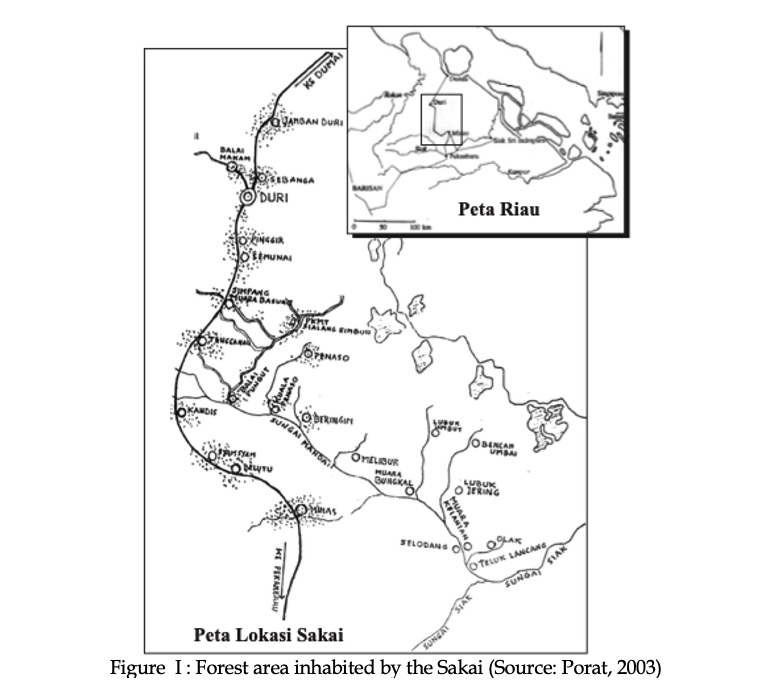Abstract
This study is about the transformation of the Sakai tribe regarding changes in the natural, socio-economic and political environment. The Sakai tribe has blended in with the community, owning companies, and holding political as well as government positions. Sakai now is the ‘new Sakai’ that is different from the ‘old Sakai’ stereotyped as backward, stupid, and introvert. The purpose of this paper is to describe the response of the Sakai tribe towards changes through their identity construction. We used ethnography as a method and the data was obtained by living in five kebatinan. The researcher lived at the research location, observed the situation, conducted in-depth interviews and had continuous discussions with the participant to deepen their understanding of the data. The data obtained was then then analyzed descriptively by discussing Warren's theory of identity construction and adaptation theory. This study found that the Sakai people adapt significantly to changes in the natural, socio-economic and political environment. One of the sources of this adaptability comes from education, that since the reformation, the Sakai people have massively made educational efforts for their younger generation. This study concludes that every community has the ability to adapt to changes in its environment based on the knowledge possessed by that community.
References
Andaya, Barbara W. (1997) “Recreating a vision; Daratan and Kepulauan in historical context,” Bijdragen tot de Taal-, Land- en Volkenkunde, Riau in transition 153, no: 4, Leiden, Page 483-5.
Ansor. Muhammad,( 2007), Kelas Menengah Sakai Dan Gerakan Civil Society, Seri Kertas Kerja JSPDL No. 4 April. Page 1-33.
Bettarini, Yulia. (1991) Dari Hidup Mengembara Menjadi Menetap: Orang Laut di Pulau Bertam Kotamadya Batam Provinsi Riau. Naskah tesis sarjana Antropologi tidak dipublikasikan, Jurusan Antropologi Budaya, Fakultas Sastra, Universitas Gadjah Mada, Yogyakarta.
Denzin, Norman K., et. al. 2009. Handbook of Qualitative Research. Yogyakarta: Pustaka Pelajar.
Dina, U., et al. (2021). Legal Review of the Existence of Customary Land of the Sakai Tribe in Kesumbo Ampai Village, Bathin Solapan District, Bengkalis Regency Based on the Basic Agrarian Law. Proceeding in The Cross Culture, and Challenge of Sustanability, vol 2.
Dove, Michael R.( 1985 )“Pendahuluan”, dalam Peranan Kebudayaan Tradisional Indonesia dalam Modernisasi, Michael R. Dove (ed.). Jakarta: Yayasan Obor Indonesia.R.
Ellis, Frank. 2000. “The Determinants of Rural Livelihood Diversification in Developing Countries.” Journal of Agricultural Economics 51(2):289–302.
Falatehan, Sriwulan Ferindian. 2017. “Pendekatan Psikologi Komunitas Dalam Memprediksi Peranan Rasa Memiliki Komunitas Terhadap Munculnya Partisipasi Masyarakat.” Manasa 6(1):66–90.
Fernanda O.O., Amady MRE, Nurti Y (2021) Suku Sakai Merebut Kebijakan Afirmatif, Buddayah: Jurnal Pendidikan Antropologi, Vol. 3, No. 2, Desember 2021, page 59 – 72.
Hijjang, P., Basir, M., & Ismail, A. (2019). Indigenous people’s environmental conservation system: case study of Kajang society, Indonesia. IOP Conference Series: Earth and Environmental Science, 343(1), 012090. https://doi.org/10.1088/1755-1315/343/1/012090.
Ismail, A., Yusuf, A. M., & Safriadi. (2019). Lamba tree: environment wisdom and its resistance to development. IOP Conference Series: Earth and Environmental Science, 343(1), 012094. https://doi.org/10.1088/1755-1315/343/1/012094.
Justicio E.D.L., Amady M.R.E. (2021). Sedao Capitalism : Growth of Sakai Enterpreniurs in Duri Riau, Budapest International Reseaah and Critis Institute-Journal (BIRCI-Journal) Volume 4 Number 4. Page 10479 -10490. Doi: https://doi.org/10.33258/birci.v4i4.3089.
Khamdevi, M., & Dewi, Y. K. (2021). The Study of The Architectural Characteristics of ‘Umah of The Sakai Tribe in Sumatra. MARKA (Media Arsitektur Dan Kota) : Jurnal Ilmiah Penelitian, 5(1), 67-72. https://doi.org/10.33510/marka.2021.5.1.67-72.
Marfuah, I., & Amady, M. R. E. (2021). Contestation for land towards Kampong Adat of Sakai Minas in Riau: . ETNOSIA : Jurnal Etnografi Indonesia, 6(2), 252 -. https://doi.org/10.31947/etnosia.v6i2.18545.
Musta’ina, F., et al. (2017). The local wisdom of the Sakai tribe in Mandau, Bengkalis Regency, in preserving forest and river: Symbolic interactionism. Proceeding in ASEAN/Asian Academic Society International Conference (AASIC), 137-144. oai:ojs.aasic.org:article/284
Muttaqien. Widhyanto & Bosniar , (2013,) Sakai Maju, di Publis di Acamedia, https://www.academia.edu/2912003/sakai_maju, di download tagal 1 November 2021, pukul 06.00 Wib.
Melalatoa, M J (1995) Ensiklopedi suku bangsa di Indonesia L-Z. Direktorat Sejarah dan Nilai Tradisional Direktorat Jenderal Kebudayaan, Jakarta.
Purba, B. (2011). Pengakuan dan Perlindungan Hak-Hak Konstitusional Masyarakat Hukum Adat Sakai. Diajukan kepada Dewan Penguji Ujian Tertutup Disertasi Program Pascasarjana Fakultas Hukum Universitas Islam Indonesia Yogyakarta: Universitas Islam Indonesia.
Porath N (2003). Ketika Burung itu Terbang, Terapi Shamanis dan Pemeliharaan Batas-batas Dunia di Kalangan Orang-orang Sakai Riau di terjemah oleh Sita Rohana tahun 2010, Pekanbaru, LAM Riau.
Porath (2008) Seeing sound: consciousness and therapeutic acoustics in the inter-sensory shamanic epistemology of the Orang Sakai of Riau (Sumatra) Journal of the Royal Anthropological Institute (N.S.) hal 647-663.
Sari D.A Soepryanto A., Burhanuddin S. (2016). Re-Design Electric Submersible Pump Pada Pt Chevron Pacific Indonesia – Minas Pekanbaru, Jurnal Ilmu dan Aplikasi Teknik Barometer, Volume 1 No.1 Page, 25-33.
Smith, A., & McBride, J. (2021). “‘Working to Live, Not Living to Work’: Low-Paid Multiple Employment and Work–Life Articulation.” Work, Employment and Society 35(2):256–76.
Suyuti, Nasruddin. (2011) Orang Bajo di Tengah Perubahan. Yogyakarta: Penerbit Ombak.
Suparlan P. (1995), Orang Sakai di Riau: Masyarakat Terasing Dalam masyarakat Indonesia Yayasan Obor Indonesia.
Tamrin H (2003). Sakai : Kekuasaan, Pembangunan, dan Marjinalisasi. Pekanbaru. Gagasan Press Redaksi Tabloid Gagasan IAIN Susqa.
Warren, J. F. (2003) “A Tale of Two Centuries: The Globalisation of Maritime Raiding and Piracy in Southeast Asia at the end of the Eighteenth and Twentieth Centuries,” ARI Working Paper, No. 2, http://www.ari.nus.edu. sg/docs/wps/wps03 _002.pdf.

This work is licensed under a Creative Commons Attribution-NonCommercial 4.0 International License.
Copyright (c) 2023 ETNOSIA : Jurnal Etnografi Indonesia





